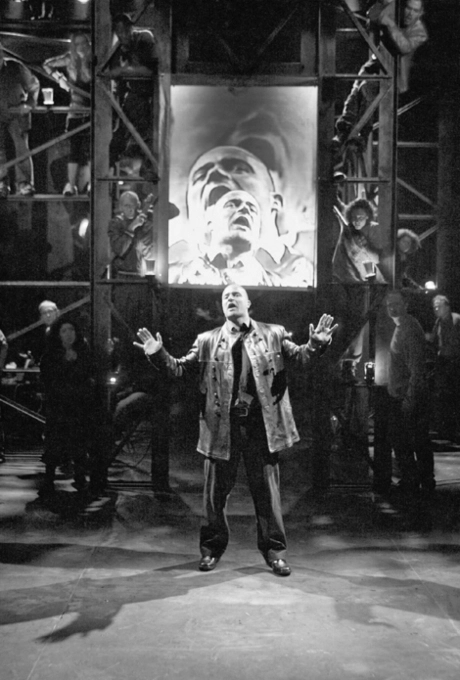A huge part of our work with the ensemble has concentrated on creating an expressionistic gestural world to capture the panic and hysteria that is unleashed in the play.
We filmed our cast and kept multiplying them, so that our group of actors could become a huge crowd. I think the template for the filming was based on two ideas provided by Bill [Dudley—designer]. The Elgin Marbles and Trajan’s Column, which depicts scenes commemorating the Emperor Trajan’s victories, fascinated him. It’s very sophisticated in the way it captures complex scenes with only a couple of centimeters of relief—it is like the very first graphic novel, or newsreel. This two-dimensional language became the main inspiration for the filming technique, alongside the work of the photographer Eadweard Muybridge. He took a series of pictures that analyzed the human body, how the muscles and limbs behaved, capturing every stage of the process. What we liked, which wouldn’t necessarily have occurred to Muybridge, was the heroic aspect of it. The men and women he captured repeating everyday actions became epic and strangely moving. I went to see the Elgin Marbles at the British Museum with Fotini Dimou, my costume designer. The depictions of these warriors, caught in violent images of killing and dying, also informed our approach to the armies and battles that are such a huge and difficult part of the play. We were really impressed by the athleticism of these Elgin warriors: semi-naked, very vulnerable, but powerful expressions of the sheer beauty of the human body.
And how did you tackle the “big speeches,” such as Mark Antony’s oration? It must be tough to make words that are so familiar seem new.
Hall: I think that is one of the traps with Shakespeare; you think that everyone knows bits really well. You just have to leave that outside the door. Those famous speeches have become famous in themselves, but people forget what’s before and what’s after, and largely, if you get the play right, you just arrive at those moments. Tom Mannion is such an extraordinary wordsman, he was so calm and charismatic and clear, he played out the action of trying to persuade the audience to tell him what they thought so well, that I think we just approached it as you would any other scene. The action in that speech for the actor playing Antony is to try and get to a point where the crowd do what you want them to do. You can’t do that by telling them; you can only do that by reasoning with them. I think it would have been an extremely popular and interesting scene for the audience of the day to watch, because I think the groundlings would have liked to think of themselves as being politically active. In Richard III there is a whole scene with the crowd and the Mayor of London where the citizens of London are needed by Richard to pull off his coup. He illustrates the power of the people again in Henry VI in Cade’s revolt.
In Caesar Shakespeare writes a scene where Antony harnesses the energy of the mob and shows how manipulative a good politician can be, to the point where they murder somebody because they get his name wrong, rather like that pediatrician who was attacked some years ago because everyone thought he was a pedophile. I think it would have been very interesting for the groundlings to have watched that scene.
Farr: That’s a good question. Sometimes with the more well-known set pieces there is a sort of pressure to shed new light on them. But I had a particular interest in media emphasis, the way in which transmission of information is manipulated, which is clearly what Antony is doing. So in our production Antony is filmed as he gives the speech and the image of him giving the speech is then projected behind him onto the screen, so you get a double image of him on screen and live. But also, rather bizarrely and because of a curious piece of chance, the camera is actually filming him but also happens to light upon the screen upon which his image is being projected. So you create what is called an infinite image of the man’s face, because the camera is filming a projection of its own image. You create about a hundred Antonys receding into the distance, and that created an extraordinary, completely accidental quality which we found in rehearsal when we were playing with the video cameras. That resonated in a way that was very powerful and as soon as that happened I knew that that would visually be the centerpiece of the speech, and then it was for the actor to explore the strange mixture of honesty and dishonesty that’s in that speech.

7. Mark Antony played by Gary Oliver in David Farr’s 2004 production at the RSC’s Swan Theatre. Using film techniques, Antony’s face was repeated on stage, and on screen “[y]ou create about a hundred Antonys receding into the distance, and that created an extraordinary, completely accidental quality.”
Is the scene with Caesar’s Ghost particularly problematic?
Hall: No. I think ghosts in Shakespeare are never problematic, they always have an action and a reason: ghosts visiting the living, they are a portent of what is going to happen. I think as long as you don’t try and make them spooky you are okay.
1 comment